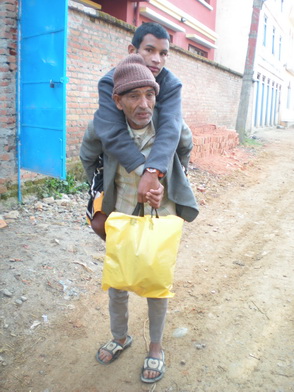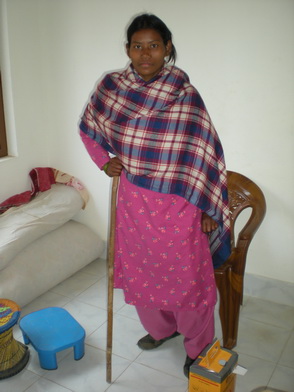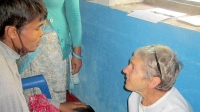Sometimes trying to summarize an experience is more difficult than the experience itself. The past two days I have spent trying to get my mind around all of the things I would like to convey about my time in Nepal. After nearly 1000 patient treatments, sometimes my days were just a blur of painful knees and low backs but that doesn't account for the miriad of emotions that I feel now that I'm on my way back to the US. I'm sure just like a million other healthcare practitioners, I now have a thousand stories of my successes and failures in the treatment room. I hope, however, that through a few of these stories, you might come to see how a much of a journey of the spirit this has been for me.
One of the things I discovered along the path is a hidden interest in paralysis, strokes and other neurological disorders. I witnessed some profound changes in these conditions using acupuncture and I would like to share a few. Of course not everyone gets better and in this fact the journey really begins.
Meet Ganesh. At eighteen years of age he contracted bone tuberculosis in his upper back. This slow growing infection is difficult to kill and in one year's time it progressed to his spine completly distroying his T9 vertebre (a condition known as Pott's spine).

At twenty, Ganesh is a parapalegic, struggles with severe pain and is without any bladder control. Everyday, his father would carry him for over an hour to reach our clinic.

Of any case I have ever treated, this was one I dearly wished to have some effect. My treatment goals were to hopefully relieve his pain and to restore some bladder function. I treated Ganesh everyday for three weeks. He also suffered from constant tremors in his legs which gradulaly started to subside with treatment and his pain was reduced to just one location in his groin, however, that was all I could do. After 25 treatments the groin pain was still just as severe and his bladder control was unchanged. I'm left with the image of Ganesh's cheerful face and the thought... maybe 100 treatments... maybe 1000. Maybe it can't be changed at all... Maybe.

Anju is nine years old, very bright and very afraid of needles (who isn't). Her father brought her to see me because six weeks ago she suddenly developed drop foot (a condition in which the anterior and lateral muscles of the lower leg are paralysed and the foot helplessly drags on the ground when walking). Anju had recieved a diagnosis of leprosy (Hansen's Disease) from the hospital in Kathmandu and her father was rightfully freaked out. I didn't know alot about leprosy or how it is diagnosed but I read everything I could find and could not determine how Anju had received such a diagnosis other than the fact that she had drop foot. I supposed that peroneal nerve entrapment was a more likely diagnosis and reasoned that it should respond to tuina and acupuncture. I agreed to treat her everyday for 10 treatments and then reevaluate. After five treatments the foot was completley unresponsive and I was begining to despair. Anju's father anxiously asked everyday what he should do and I could feel his skeptisism and fear increasing as the days went by without change. I was begining to think that surgury might be a better treatment strategy when after the sixth treatment I asked Anju to lift her foot... it lifted. My interpeter and I nearly fell over with suprise and Anju's father openly wept. The foot was very weak but functional and I encouraged her father to bring her back for more treatment until she had fully recovered. I never saw her again. I can only hope that she enjoyed a rapid and full recovery... but I don't know that

Ganga, is a patient that I inherited from Diane when she returned to the US. This young woman fell off the roof of a building while trying to escape a beating she was receiving from her husband. It is unknown exacly what damage she sustained to her spine becase she did not receive any medical care after the accident. She spent one year in bed recovering and came to our clinic mostly paralysed below the waist. I remember the first time I treated Ganga because she would intently watch each needle insertion and try to connect to some sensation of it. Contrast that to the fact that 5 weeks later she was complelty needle sensitive and would walk an hour and a half each way to the clinic without pain. Not to say she was cured in any way as her walking was not a pretty sight to behold and she still lacked function in the anterior and lateral muscles of her lower legs.

The really amazing part for me was to see the revitalization of spirit in this young women. In the few short weeks I worked with her I saw hopelessness surrender to the bright light of hope behind her dark eyes and I will not soon forget the power of this transformation.

Mr. Noresh is a 42 year old police officer who suffered a sudden stroke nine years ago and is mostly paralysed on his right side and cannot speak clearly. I learned in school that recovery of motor function after such a long time is extremely unlikely but I agreed to try. After only 5 treatments I was shaking his hand. He could move each finger individualy and he could walk with a cane (he could not hold his cane before). When I began working with him he claimed that I could "cut off his leg" and he wouldn't be able to feel it. After treatment he had sharp/dull and soft touch sensitivity in all of his fingers and toes. The interpeters all reported that he was speaking much clearer than before. He's one happy guy. I'm one happy practitioner and I hope he will continue to improve.

One of my favorite patients was this young girl who contracted typhoid fever at age 16. The fever damaged her cerebelum (part of the brain responsible for coordinating movement and balance) and now she has difficulty walking and falls often. I can't say that my treatments had even the slightest effect on her condition but I can say that her attitude and bright smile had a profound effect on me. On days that I would be struggling in the clinic wondering why some people wern't responding or worring that I might have missed something that would cause someone harm, she would come in and tell me a joke or sing a song. Attitude is so important in influencing outcomes and I am so grateful to this patient for that constant reminder.
In fact, I will end this entry on this note. I'm eternally grateful for what each and every patient brought to me on this journey. They shared their stories, they shared themselves and they trusted me. I hope I helped... I know they all helped me. -Andrew











